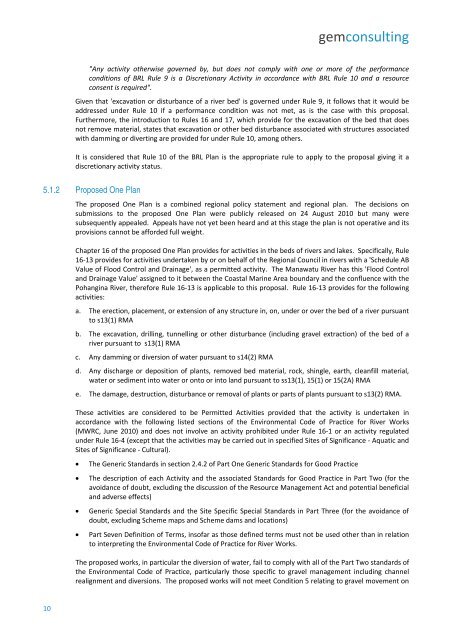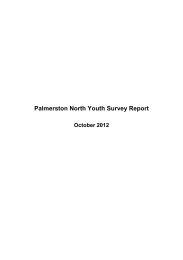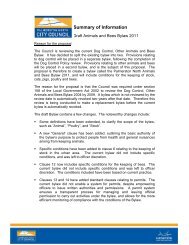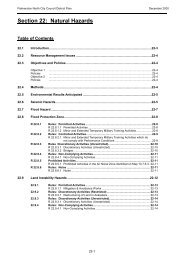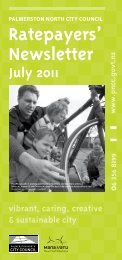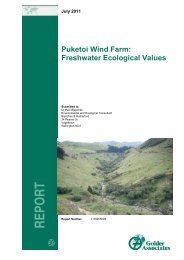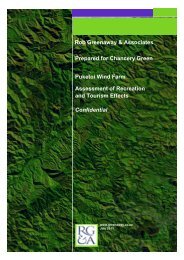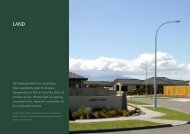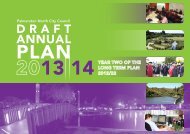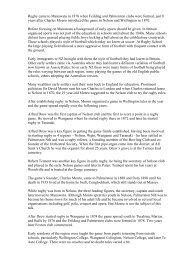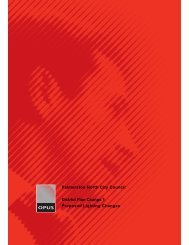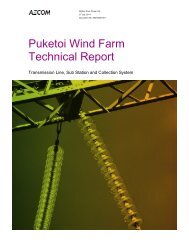Part 1 - Palmerston North City Council
Part 1 - Palmerston North City Council
Part 1 - Palmerston North City Council
You also want an ePaper? Increase the reach of your titles
YUMPU automatically turns print PDFs into web optimized ePapers that Google loves.
gemconsulting<br />
"Any activity otherwise governed by, but does not comply with one or more of the performance<br />
conditions of BRL Rule 9 is a Discretionary Activity in accordance with BRL Rule 10 and a resource<br />
consent is required".<br />
Given that 'excavation or disturbance of a river bed' is governed under Rule 9, it follows that it would be<br />
addressed under Rule 10 if a performance condition was not met, as is the case with this proposal.<br />
Furthermore, the introduction to Rules 16 and 17, which provide for the excavation of the bed that does<br />
not remove material, states that excavation or other bed disturbance associated with structures associated<br />
with damming or diverting are provided for under Rule 10, among others.<br />
It is considered that Rule 10 of the BRL Plan is the appropriate rule to apply to the proposal giving it a<br />
discretionary activity status.<br />
5.1.2 Proposed One Plan<br />
The proposed One Plan is a combined regional policy statement and regional plan. The decisions on<br />
submissions to the proposed One Plan were publicly released on 24 August 2010 but many were<br />
subsequently appealed. Appeals have not yet been heard and at this stage the plan is not operative and its<br />
provisions cannot be afforded full weight.<br />
Chapter 16 of the proposed One Plan provides for activities in the beds of rivers and lakes. Specifically, Rule<br />
16‐13 provides for activities undertaken by or on behalf of the Regional <strong>Council</strong> in rivers with a 'Schedule AB<br />
Value of Flood Control and Drainage', as a permitted activity. The Manawatu River has this 'Flood Control<br />
and Drainage Value' assigned to it between the Coastal Marine Area boundary and the confluence with the<br />
Pohangina River, therefore Rule 16‐13 is applicable to this proposal. Rule 16‐13 provides for the following<br />
activities:<br />
a. The erection, placement, or extension of any structure in, on, under or over the bed of a river pursuant<br />
to s13(1) RMA<br />
b. The excavation, drilling, tunnelling or other disturbance (including gravel extraction) of the bed of a<br />
river pursuant to s13(1) RMA<br />
c. Any damming or diversion of water pursuant to s14(2) RMA<br />
d. Any discharge or deposition of plants, removed bed material, rock, shingle, earth, cleanfill material,<br />
water or sediment into water or onto or into land pursuant to ss13(1), 15(1) or 15(2A) RMA<br />
e. The damage, destruction, disturbance or removal of plants or parts of plants pursuant to s13(2) RMA.<br />
These activities are considered to be Permitted Activities provided that the activity is undertaken in<br />
accordance with the following listed sections of the Environmental Code of Practice for River Works<br />
(MWRC, June 2010) and does not involve an activity prohibited under Rule 16‐1 or an activity regulated<br />
under Rule 16‐4 (except that the activities may be carried out in specified Sites of Significance ‐ Aquatic and<br />
Sites of Significance ‐ Cultural).<br />
<br />
<br />
<br />
<br />
The Generic Standards in section 2.4.2 of <strong>Part</strong> One Generic Standards for Good Practice<br />
The description of each Activity and the associated Standards for Good Practice in <strong>Part</strong> Two (for the<br />
avoidance of doubt, excluding the discussion of the Resource Management Act and potential beneficial<br />
and adverse effects)<br />
Generic Special Standards and the Site Specific Special Standards in <strong>Part</strong> Three (for the avoidance of<br />
doubt, excluding Scheme maps and Scheme dams and locations)<br />
<strong>Part</strong> Seven Definition of Terms, insofar as those defined terms must not be used other than in relation<br />
to interpreting the Environmental Code of Practice for River Works.<br />
The proposed works, in particular the diversion of water, fail to comply with all of the <strong>Part</strong> Two standards of<br />
the Environmental Code of Practice, particularly those specific to gravel management including channel<br />
realignment and diversions. The proposed works will not meet Condition 5 relating to gravel movement on<br />
10


